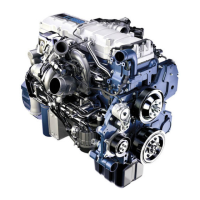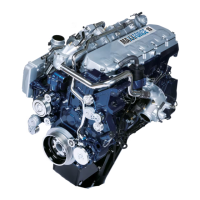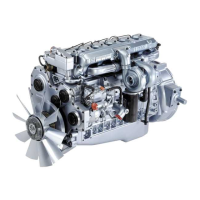586 10 TERMINOLOGY
Cetane number – 1. The auto ignition qu ality of dies el
fuel.
2. A rating applied to diesel fuel similar to o cta ne
rating for gasoline.
3. A measure of how readily diesel fuel starts to burn
(autoignites) at high compression temperature.
Diesel fuel with a high cetane number autoignites
shortly after injection into the comb ustion chamber.
Therefore, it has a short ignition delay time. D iesel
fuel with a low cetane number resists autoignition.
Therefore, it has a longer ignition delay time.
Charge air – Dense, pressurized, heated air
discharged from the turbocharger.
Charge Air Cooler (CAC) – See After cooler.
Closed crankcase – Crankcase ventilation system
that recycles crankcase gases through a breather,
then back to the clean ai r intake.
Closed loop operation – A system that uses a sensor
to provide feedback to the ECM. The ECM uses the
sensor to continuously monitor variables and it make
adjustments to match engine requirements.
Cloud point – The point when w ax crystals occur in
fuel, making fuel cloudy or hazy. Usually below –12°C
(10°F).
Cold cranking ampere rating (battery rating) – The
sustained constant current (in amperes) needed to
produce a minimum terminal voltage under a load of
7.2 volts per battery after 30 seconds.
Continuous Monitor Test – An ECM function that
continuously monitors the inputs and outputs to
ensure that readings are within set limits .
Controller Area Network (CAN) – This is a J1939
high speed communication link. CAN 1 is a public
drive train data link between the v eh icle mod u les and
ECM. CAN 2 is a private link between the ECM and
IDM.
Coolant – A fluid used to transport heat from one point
to another.
Coolant level switch – Aswitchusedtoindicate
coolant level.
Cooling system capacity (volume) – The amount
of coolant that completely fills a c o oling system to its
designated cold leve l m a rk . (SAE J1 00 4 SEP81)
Crankcase – The housing that encloses the
crankshaft, connecting rods, and allie d parts.
Crankcase breather – A vent for the crankcase to
release excess interior air pressure.
Crankcase pressure – The force of air inside the
crankcase against the crankcase housing.
Crankshaft (CKP) sensor – The CKP sensor is a
magnetic pickup sensor that indicates crankshaft
speed and position.
Current – The flow of electrons passing through a
conductor. Measured in amperes.
Damper – A device that reduces the amplitude of
torsional vibration. (SAE J1479 JAN85)
Deaeration – The removal or purging of gases (air or
combustion gas) entrapped in coolant or lubricating
oil.
Deaeration tank – A separate tank in the cooling
system used for one or more of the following functions:
• Deaeration
• Coolant reservoir (fluid expansion and after boil)
• Coolant retention
• Filling
• Fluid level indica tio n (visible)
Diagnostic Trouble Code (DTC) – Form erly called
a Fault Code or Flash Code. A DTC is a three digit
numeric code used for troubleshooting.
Diamond Logic® Engine Brake – The Diamond
Logic® Engine Brake is a compression release
braking system that uses a high-pressure oil rail
components together with the VGT for additional
braking. The operator controls the engine brake for
different operating conditions.
Diamond Logic® Exhaust Brake – The D iamond
Logic® Exhaust Brake is an exhaust brake system
that uses only the VGT to restrict exhaust flow for
additional braking. The operator controls the exhaust
brake for different operating conditions.
Digital Multimeter (DMM) – An electronic meter that
uses a digital display to indicate a measured value.
Preferred for use on microprocessor systems because
it has a very high internal impedance and will not load
down the circuit being me as ured .
EGES-270-1
Read all safety instructions in the "Safety Information" section of this manual before doing any procedures.
Follow all warnings, cautions, and notes.
© August 2008 Navistar, Inc.

